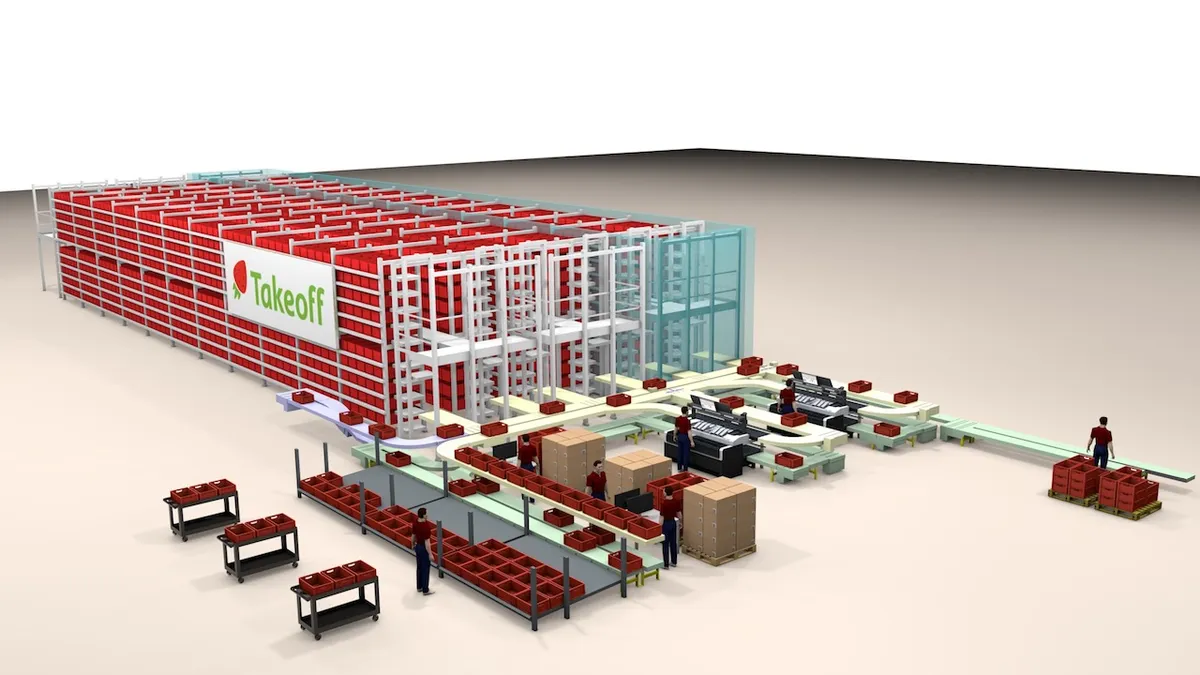Dive Brief:
- Micro-fulfillment pioneer Takeoff Technologies announced it has raised $25 million in Series C funding, equaling 5% of the company's $500 million valuation, according to a press release emailed to Grocery Dive. The capital infusion, led by current investor Forrestal Capital, will fuel Takeoff's expansion across North America, Europe and Australia. The company has raised $86 million to date.
- Takeoff also announced next year it's rolling out an updated version of its automated warehouses that will process orders 6% faster and store more products. The facility will feature, according to the company, "a smaller and cleaner design of the [micro-fulfillment center’s] floorspace, allowing for easier construction and installation."
- Israeli firm CommonSense Robotics, which recently unveiled an underground micro-fulfillment shed, has rebranded as Fabric. The move is meant to convey the company's broader focus on last-mile logistics. Fabric also announced it has moved its headquarters from Tel Aviv, Israel to New York City and hired two new executives — chief financial officer Patrick Davis, who has over 15 years of leadership experience in technology, and chief commercial officer, Steve Hornyak, who brings 30 years of retail tech leadership experience to the job.
Dive Insight:
Micro-fulfillment has become one of the buzziest technologies in grocery over the past year or so. As e-commerce grows, companies like Takeoff and Fabric are looking beyond the pilot phase and positioning themselves for wider implementation.
Takeoff, which currently operates several micro-fulfillment centers in partnership with Ahold Delhaize, Sedano's and Albertsons, says its version 2.0 shed will utilize its floor space with greater efficiency — promising savings that get passed along to the retailers it works with. Along with greater storage capacity, the warehouses will have so-called "open shuttles" rolling around and helping fill orders.
Takeoff recently opened its first standalone micro-fulfillment center, located in Clifton, New Jersey and servicing 10 locations operated by Inserra Supermarkets and its ShopRite stores. The company had previously attached its automated centers to existing grocery stores, fulfilling for that particular location as well as others in the area. Its advanced artificial intelligence and robotics can assemble as many as 60 orders in just a few minutes.
The premise behind micro-fulfillment is simple enough: Improve the speed and efficiency of online order fulfillment while also relieving pressure on store inventory. The execution, however, is very complex, requiring a high volume of e-commerce orders to become economically viable. Time will tell whether MFCs offer long-term savings and speed of fulfillment that justify their hefty upfront cost.
Fabric didn't say specifically what aspects of last-mile logistics it will focus on. CEO Elram Goren noted in the release that the rebrand — carried out in concert with branding agency Red Antler, which was also behind the Casper and Allbirds brands — "reflects our vision to transform last-mile logistics so that on-demand e-commerce becomes a profitable and scalable business for all retailers."
Fabric has been in discussions with U.S. retailers, and last year told Grocery Dive it planned to announce partnerships with five major grocers across this year and next. With its New York City headquarters and U.S.-based executives, the company that promised to put fulfillment centers close to customers' homes is now putting itself closer to the action in the fast-evolving North American grocery scene.
Both companies join the parade of tech firms on display at this week's Groceryshop conference in Las Vegas. And most, if not all, are pitching retailers on their ability to both innovate and save them money as they hurtle into the digital retailing age. On Sunday, analysts with IGD presented research stating that global supply chain leaders see increasing operating costs as the number one challenge they currently face. According to IGD's survey, 86% of respondents say the complexity of supply chain operations has increased over the past five years.













